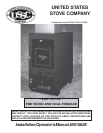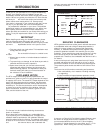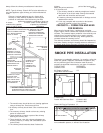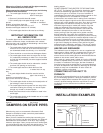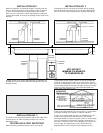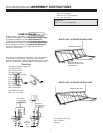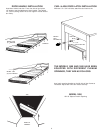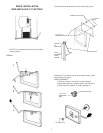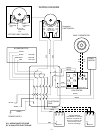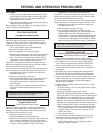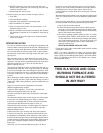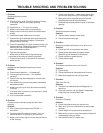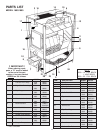
When using a Class A or double wall flue pipe connection,
follow the manufacturer's instructions.
When constructing a single wall smoke pipe, the following
guidelines must be observed.
1. The smoke pipe should be 24 gauge or heavier
stainless steel or black pipe.
2. Secure all joints with three #8 screws.
3. If the smoke pipe must pass through a wall, an ap-
proved insulated or ventilated
thimble, at least three times the diameter
of the smoke pipe must be used. (i.e. a 6"
diameter smoke pipe needs an 18" thimble).
4. The smoke pipe should not be used as a chimney.
IMPORTANT INFORMATION FOR
ALL SMOKE PIPES
The smoke pipe must be constructed and installed so that it
maintains clearances, keeps condensation and creosote
within the pipe, and is capable of withstanding a two to three
thousand degree chimney fire.
1. The smoke pipe should slant down toward the furnace a
minimum of 1/4" to the foot. At no time should the pipe
turn downward toward the chimney or run horizontal.
2. There should be no more than two 90 degree elbows.
3. The smoke pipe should never be longer than six feet.
If it is absolutely necessary to make a run of more than
six feet (not recommended) use extra support brackets
every 3 feet.
4. The smoke pipe should never be reduced to a smaller
size than flue opening on the furnace.
5. The smoke pipe should not block the flue of the
chimney or extend into it in any
way.
6. A good airtight thimble should be used to hold the
smoke pipe in the chimney. It
should be constructed so the smoke
pipe can be removed for cleaning.
7. The smoke pipe should not leave the heated portion of
the building to reach the chimney.
8. The smoke pipe should not pass from one story to the
next before entering the chimney, nor should it pass
through any closed or enclosed space.
9. Heat reclaimers should not be installed or used in the
smoke pipe.
10. The smoke pipe should not be located near or in a walk
way or well traveled area.
11. All male ends of smoke pipe should run or point
towards the furnace.
DAMPERS ON STOVE PIPES
When burning coal, we recommend a Barometric Draft
Damper be installed at a safe convenient place between
chimney and your furnace.
When you have installed the smoke pipe connecting your
furnace to the chimney, tap the pipe hard with your fingernail.
Remember the sound it makes - it will be a "ting" echoing
inside the stove pipe. If later you tap and hear a muffled thud,
you are building up soot in the pipe and should clean it. This
pipe should be cleaned at least once or twice during the
heating season.
DO NOT CONNECT TWO HEATERS TO THE SAME CHIM-
NEY FLUE. The National Fire Prevention Association recom-
mends that woodburning appliances vent into a separate
chimney from gas or oil furnaces. If such an installation is
contemplated, first check with a local building inspector to find
out if a separate flue for a woodburner is required.
If codes allow, use extreme care in making such installations.
Be sure that one pipe is higher than the other so that the two
openings will not be opposite each other. Also, when connect-
ing two heaters into the same chimney flue, the flue size
should be large enough to handle both heaters. Very few
codes and standards allow same flue connection. Such
installations can cause severe problems. Gas hoods and
barometric dampers allow excess air into the chimney
causing cooling of the flue gases and a greater creosote
build-up potential. If the same flue connections are used,
chimneys must be inspected more frequently and the chimney
should be cleaned any time the creosote deposits exceed 1/4"
thickness. A creosote fire in such a chimney can burn out of
control because of the air leak through the barometric damper
or gas hood. Keeping the chimney clean and burning well-
seasoned wood is absolutely necessary. This type of installa-
tion does require more frequent inspection and maintenance.
HEATED AIR DISCHARGE
The Hotblast furnace is designed for use as a supplemental
heating source. When used as a supplementary furnace, the
1600/1800 is connected in conjunction with an oil, gas, or
electric furnace to the existing duct work which distributes the
heated air into several rooms and/or areas.
When used as a space heater, heated air from the 1600/1800
furnace is expelled directly into the room in which the furnace
is located. In installations of this type, the flow of heated air
from the furnace must not be blocked. It is recommended that
an elbow be attached to the heated air discharge to divert the
heated air away from combustibles. All other criteria for
installation remains unchanged.
CONNECTING HOT AIR DUCT TO
FURNACE
We strongly recommend that the hot air duct work be installed
by a home heating specialist. If doing the installation yourself,
before you decide which installation will best suit your needs,
consult a qualified heating technician and follow his recom-
mendations as to the safest and most efficient method of
installation.
The following illustrations are the only acceptable configura-
tions when installed with existing oil or gas furnaces.
INSTALLATION EXAMPLES
EXISTING
FURNACE
HOTBLAST
FURNACE
BACK
DRAFT
DAMPER
3



